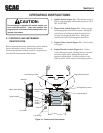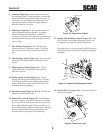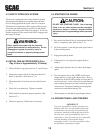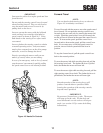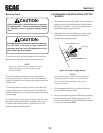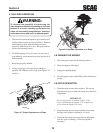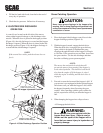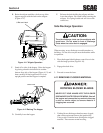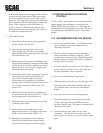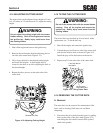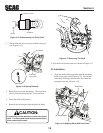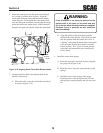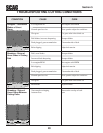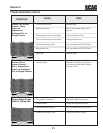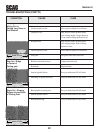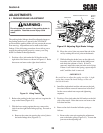
16
Section 4
4.12 MOVING MOWER WITH ENGINE
STOPPED
To “free-wheel” or move the mower around without the
engine running, place the dump valve handle in the
FREE-WHEEL position (Figure 4-2). Disengage the
parking brake and move the mower by hand. The lever
must be returned to the DRIVE position to drive the
mower.
4.13 RECOMMENDATIONS FOR MOWING
1. Do not mow with dull blades. A dull blade will tear
grass, resulting in poor lawn appearance and
requiring extra power.
2. Direct the side discharge away from sidewalks or
streets to minimize cleanup of clippings. When
mowing close to obstacles, direct the discharge away
from the obstacles to reduce the chance of property
damage by thrown objects.
3. Cut grass when it is dry and not too tall. Do not cut
grass too short (cut off 1/3 or less of existing grass
for best appearance). Mow frequently.
4. Keep mower and discharge system clean.
5. When mowing wet or tall grass, mow the grass twice.
Raise the mower to the highest setting for the first
pass and then make a second pass to the desired
height.
6. Use a slow travel speed for trimming purposes.
7. Operate the engine at or near full throttle for best
cutting. Mowing with a lower RPM causes the
mower to tear the grass. The engine is designed to be
operated at full speed.
8. Use the alternate stripe pattern for best lawn
appearance. Vary the direction of the stripe each
time the grass is mowed to avoid wear patterns in the
grass.
2. If the blower intake becomes clogged, there could be
a distinct change in the sound of the blower and/or
the mower deck will begin to leave a trail of glass
clippings. The clogging will generally develop in the
back of the mower deck in the opening of the blower
chute. When clogging occurs at this point, it's
usually caused by something restricting the flow
throughout the entire system and the system should
be checked if a pattern develops.
3. Check the following:
A. Check that the blades are properly installed for
correct rotation. See Section 7.
B. Check that the cutting height is not too low.
When cutting thick, tall grass, lower cutting
height settings tend to restrict the airflow moving
into and under the deck.
C. Check that the deck housing and baffling is free
of grass and dirt buildup. Some material buildup
can be tolerated, but when a buildup occurs that
restricts the flow of air and grass clippings, the
mower deck must be cleaned.
D. Check that the blades have enough flat section at
the blade tip. Sharpening of the blades will
remove this flat section and if too much is
removed, the air lift capability of the blade is
greatly reduced. Replace the blades if more than
1/3 of blade is removed at the blade tip. See
section 7.10.
E. Check the discharge chutes for accumulation of
dirt and material that would restrict flow. Clean
the discharge chutes as described above.
F. Check the elbow inside the hopper for a buildup
of material in the radius.
G. Check that the screen in the hopper is not
plugged with materials. If plugged, remove and
clean screen as described in section 7.13.
H. Remember, anything that restricts airflow or
material flow along the entire path from the
mower deck to the hopper can cause clogging.



